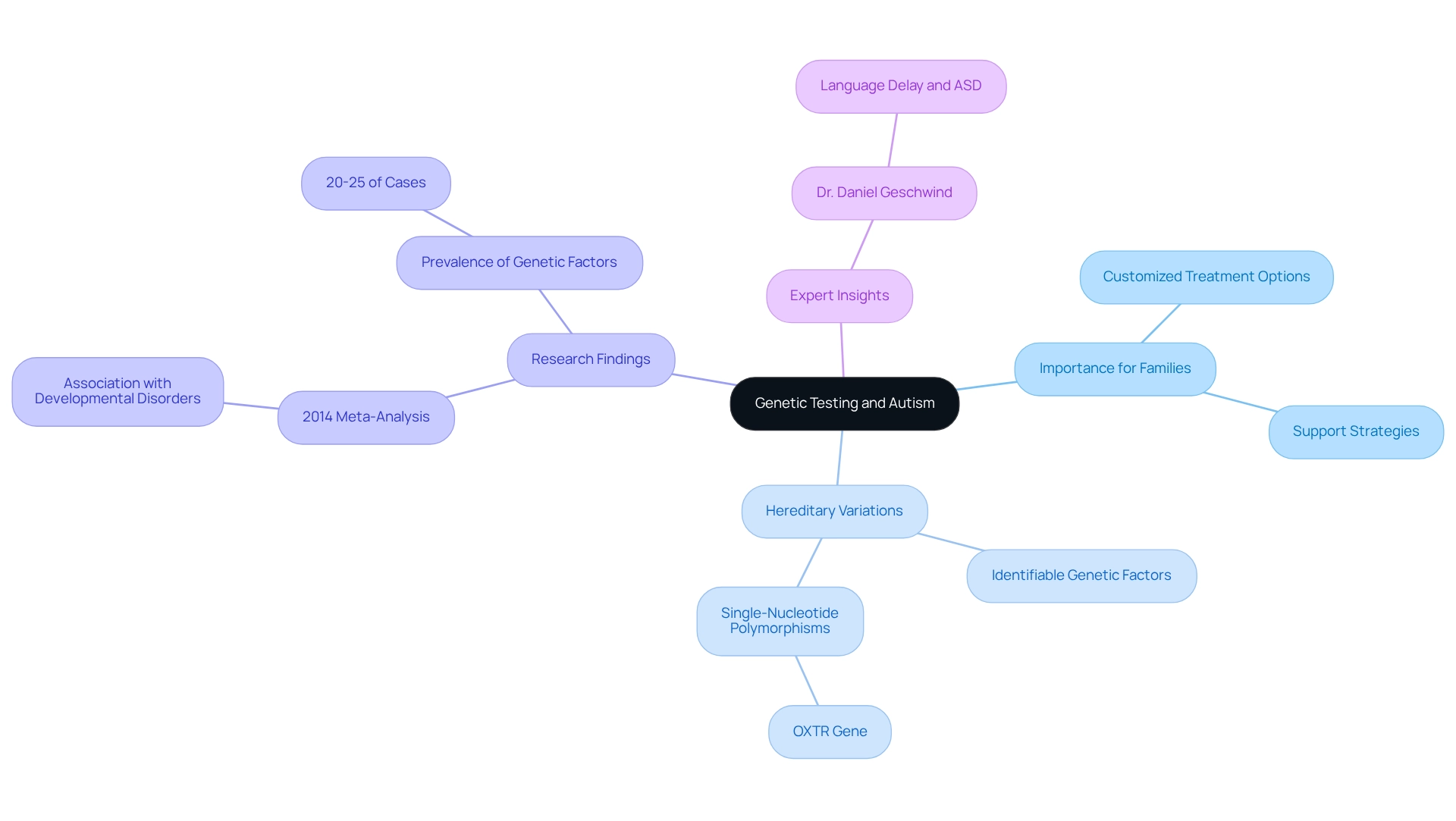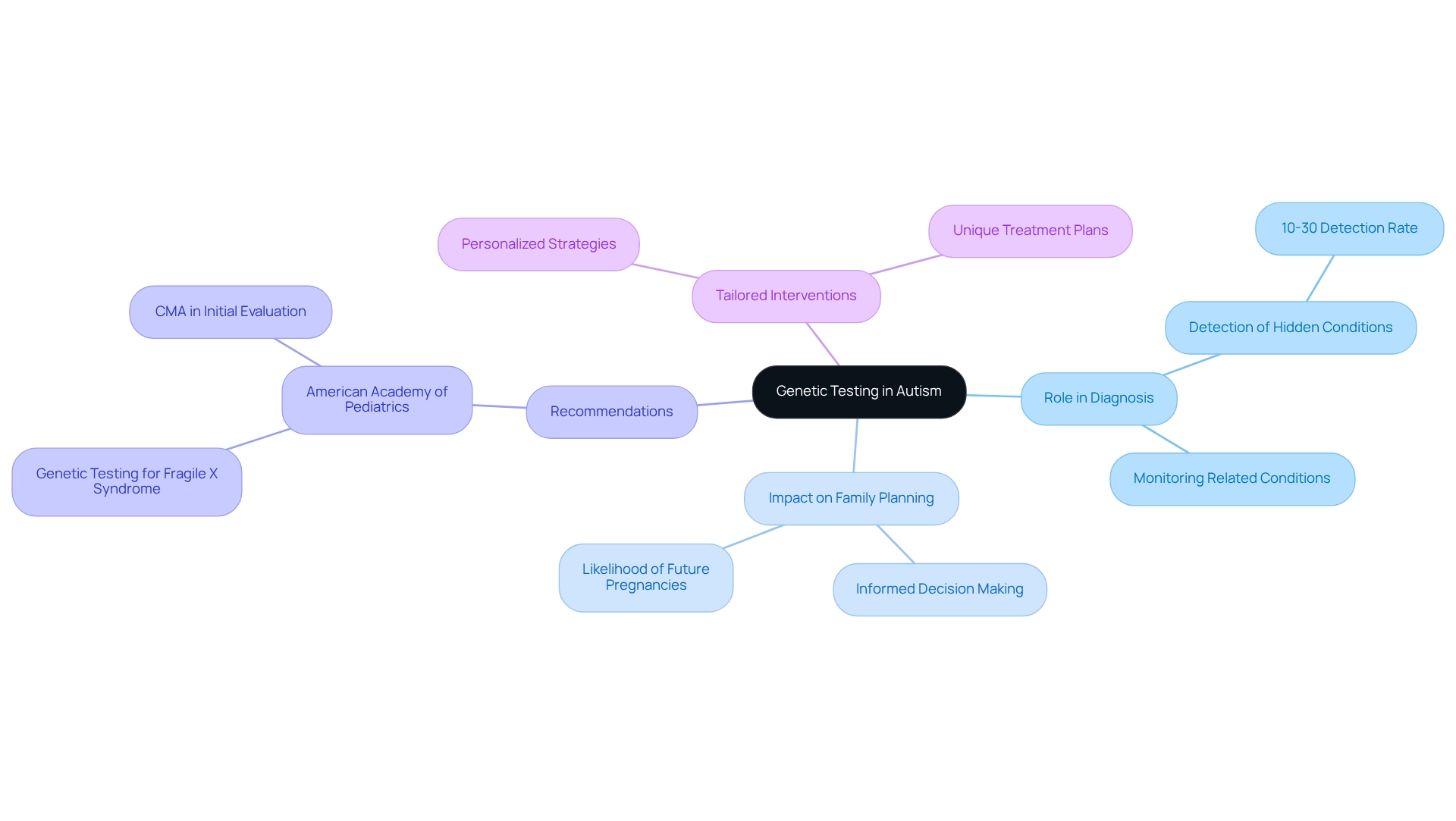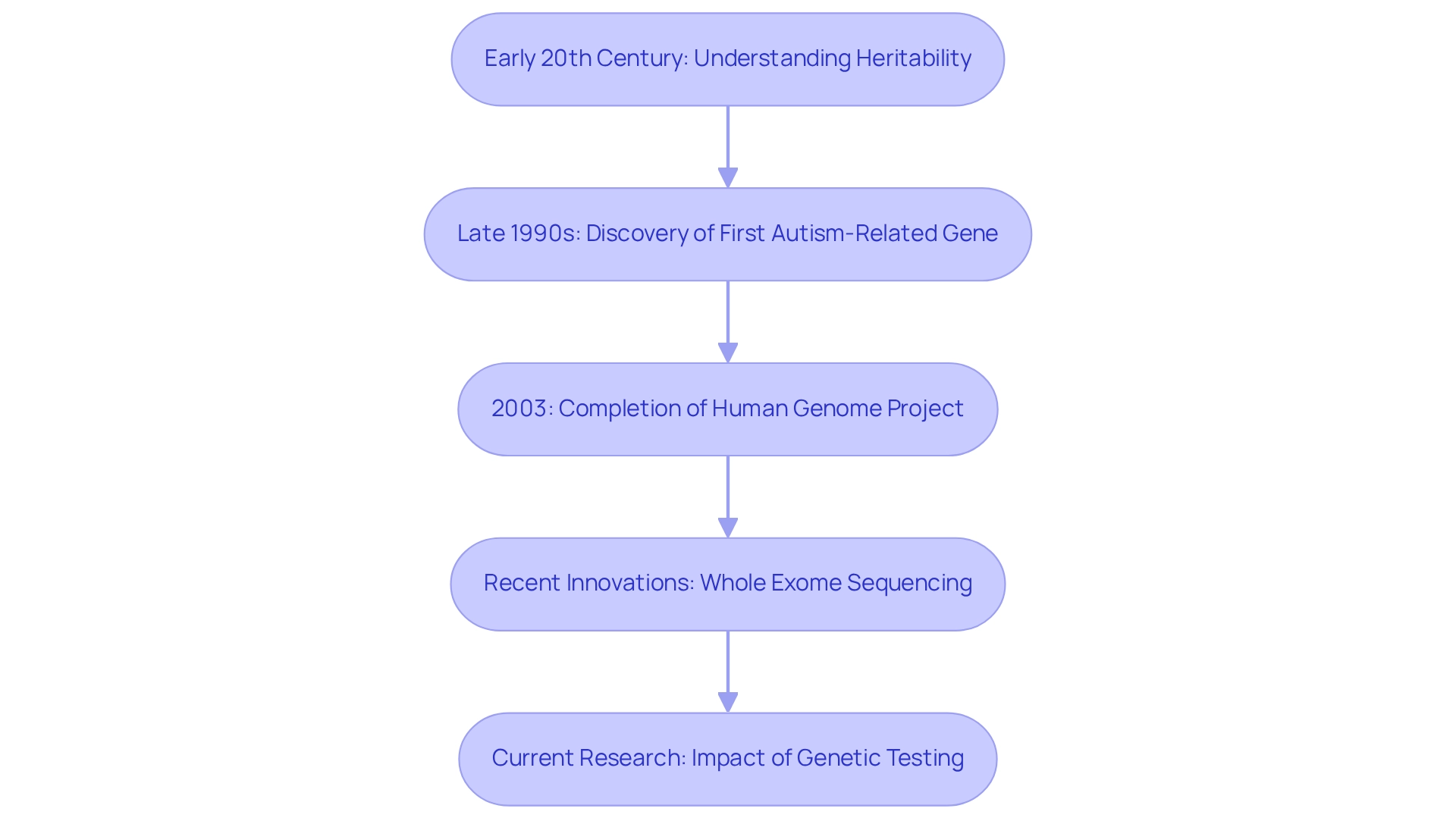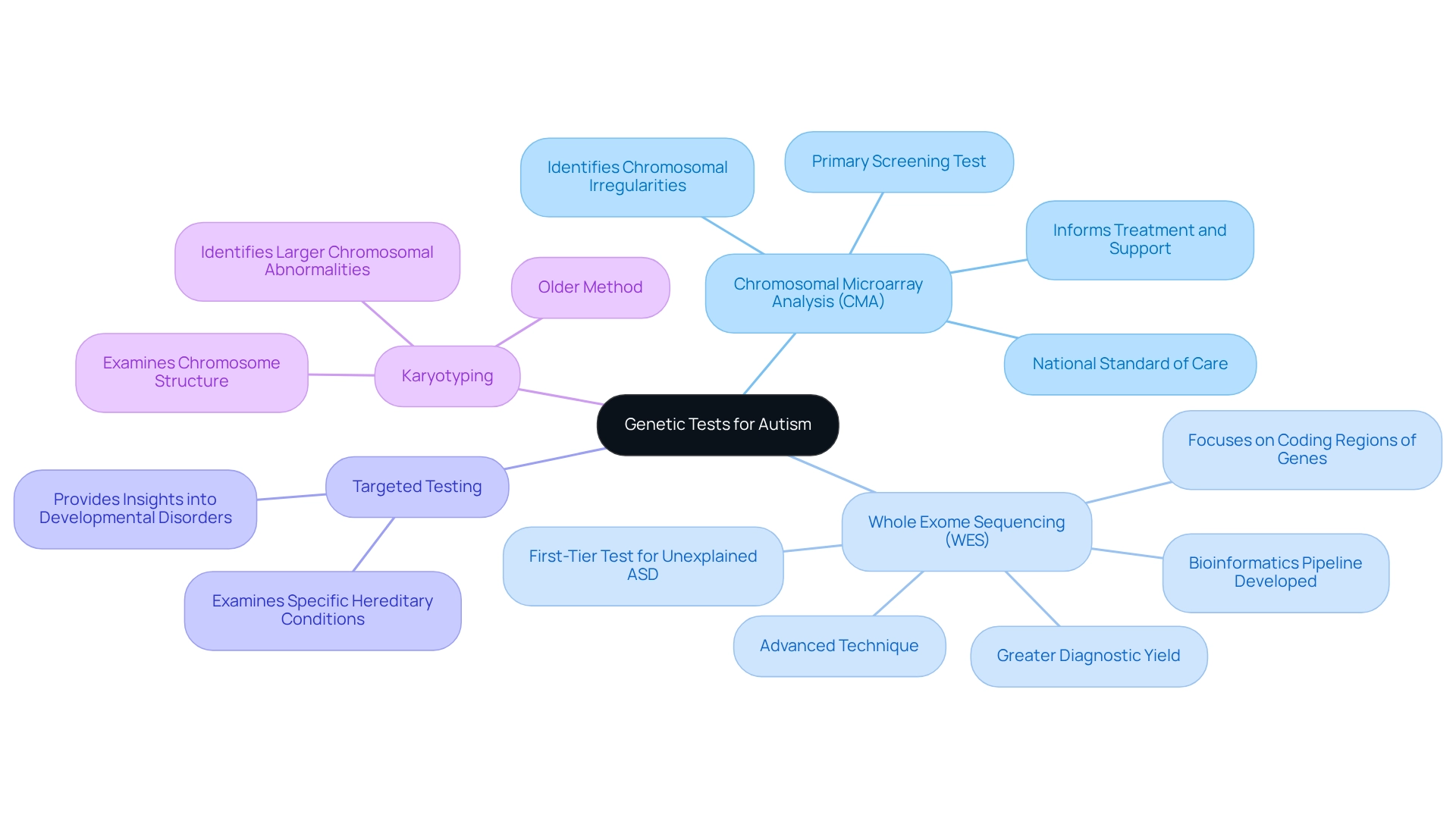Overview
Genetic testing is an important tool in understanding autism spectrum disorder (ASD), as it helps identify hereditary factors that may contribute to the condition. While it doesn't provide a definitive diagnosis, it opens doors to understanding. For many parents, the journey can feel overwhelming. Tests like Chromosomal Microarray Analysis (CMA) and Whole Exome Sequencing (WES) can uncover genetic variations linked to ASD. This knowledge empowers families to seek tailored interventions that address their unique challenges. By navigating the complexities of developmental disorders together, we can foster a supportive community where parents feel understood and equipped. If you’re on this journey, consider exploring these testing options to gain insights that can guide your family’s path forward.
Introduction
In the journey to understand the complexities of autism spectrum disorder (ASD), genetic testing stands out as a vital resource. It not only enhances diagnostic accuracy but also informs personalized treatment strategies, offering hope to families. As technology advances, researchers have made remarkable progress in uncovering the genetic factors associated with autism. This exploration reveals that a significant percentage of cases are linked to identifiable genetic variations, shedding light on the intricate landscape of autism.
For families and clinicians, the role of genetic testing is increasingly essential. It provides insights that can lead to tailored interventions and improved outcomes for individuals with ASD. From the historical milestones that shaped genetic research to the diverse testing methodologies available today, this article delves into how genetic testing is transforming our understanding and management of autism. Ultimately, it paves the way for more effective support for individuals and their families, fostering a brighter future together.
Define Genetic Testing and Its Relevance to Autism
Understanding DNA analysis can be a pivotal step for parents navigating the complexities of developmental disorders, such as ASD, particularly in relation to what does genetic testing show autism. This assessment delves into a person's genetic makeup, identifying hereditary variations linked to specific conditions. By uncovering these potential hereditary elements, families can explore customized treatment options and support strategies tailored to their child's unique needs.
While hereditary analysis alone may not diagnose a disorder, it provides valuable insights into the biological underpinnings of conditions like ASD, raising the question of what does genetic testing show autism. Recent studies indicate that approximately 20-25% of developmental disorder cases are associated with identifiable genetic factors, which raises the question of how does genetic testing show autism in the diagnostic journey.
For instance, a 2014 meta-analysis revealed significant links between developmental disorders and certain single-nucleotide polymorphisms in the OXTR gene, which is crucial for social behavior. This finding illustrates how genetic analysis can shed light on the biological aspects of social behavior challenges faced by individuals with developmental disorders, paving the way for more effective interventions.
Experts in the field, including Dr. Daniel Geschwind, emphasize the importance of understanding how does genetic testing show autism and the genetic framework of these conditions. He noted, "This association of general risk for ASD that was strongest in those with language delay suggests that language is actually a core component of ASD." This perspective reinforces the critical role of genetic analysis in enhancing outcomes for individuals with ASD, encouraging families to seek out these assessments as part of their support journey.

Contextualize Genetic Testing in Autism Diagnosis and Management
Genetic analysis plays a vital role in identifying and managing developmental disorders, offering insights that pave the way for personalized interventions. For many parents, understanding the genetic factors at play can be both enlightening and reassuring. Studies indicate that hereditary evaluations can uncover hidden conditions in approximately 10-30% of individuals diagnosed with spectrum disorder. This crucial identification allows healthcare providers to recommend specific treatments that address co-occurring conditions, such as epilepsy and intellectual disabilities, which are often associated with the spectrum.
Moreover, hereditary analysis is essential for family planning. It informs parents about the likelihood of having another child with autism, empowering them to make informed decisions regarding future pregnancies. The American Academy of Pediatrics advocates for hereditary screening for Fragile X syndrome and recommends chromosomal microarray analysis (CMA) as part of the initial diagnostic assessment for patients with ASD, underscoring its importance in the diagnostic process.
A recent study highlighted the profound impact of establishing a hereditary diagnosis. This not only aids in monitoring related conditions but also enhances prognostication and predicts recurrence risk. Such insights can offer much-needed closure for families who are navigating the often complex and lengthy diagnostic journeys. As noted in the Annals of Indian Academy of Neurology, 'our study reiterates the value of WES as a first-tier test for unexplained ASD.'
As advancements in hereditary analysis continue, its integration into the care of developmental disorders is expected to grow, providing families and healthcare professionals with invaluable insights for more effective interventions. Tailored interventions are personalized strategies developed based on hereditary findings, ensuring that treatment plans are specifically designed to meet the unique needs of each child. Together, we can foster a supportive environment that prioritizes the well-being of every child and family.

Trace the Historical Development of Genetic Testing for Autism
The journey of DNA testing for developmental disorders began in the early 20th century, when researchers sought to understand the heritability of these conditions. A pivotal moment arose in the late 1990s with the discovery of the first autism-related gene, marking a significant milestone in hereditary research. Notably, mathematical models indicate that about a quarter of autistic children inherit copy number variations from their parents, underscoring the hereditary aspect of autism. The completion of the Human Genome Project in 2003 accelerated advancements in this field, paving the way for more thorough studies of heredity.
Recent innovations, particularly whole exome sequencing (WES) and chromosomal microarray analysis (CMA), have transformed research on developmental disorders. These technologies play a crucial role in identifying various hereditary variants linked to autism, which raises the question of what does genetic testing show about autism, enhancing diagnostic accuracy and deepening our understanding of the genetic components contributing to this spectrum disorder. Moreover, research reveals that many autistic children often face comorbid conditions like anxiety, ADHD, and sleep issues, highlighting the urgent need for comprehensive support systems, while also examining how does genetic testing show autism and underscores the complexity of the condition, illustrating the interplay between genetic predispositions and environmental factors. As noted by Daniel H. Geschwind, significant disparities in diagnosis and treatment exist based on socioeconomic status, adding another layer of complexity to our understanding of autism.
Furthermore, a 2015 study found evidence that non-shared environmental factors influence social impairments in individuals with autism, showcasing the multifaceted nature of this condition. As we navigate these challenges together, it’s essential to foster a supportive community, sharing experiences and resources that can help families find the understanding and care they need.

Identify Key Characteristics and Types of Genetic Tests for Autism
In the journey of diagnosing autism, an important question is, does genetic testing show autism, as it offers insights that can be both enlightening and reassuring for families. Understanding the various types of tests available is crucial for navigating this complex landscape.
- Chromosomal Microarray Analysis (CMA) stands out as the primary screening test for individuals with autism spectrum condition (ASD). This test identifies submicroscopic chromosomal irregularities that may be linked to the condition. Its recognition as a national standard of care highlights its importance in clinical practice. CMA is not just a test; it serves a real purpose in identifying hereditary factors that can inform treatment and support strategies, providing hope for families seeking answers.
- Moving forward, Whole Exome Sequencing (WES) represents an advanced technique that focuses on the coding regions of genes. This allows for the identification of mutations that may contribute to developmental disorders. WES offers a greater diagnostic yield than conventional methods, making it a significant tool in understanding hereditary contributions to ASD. The American College of Medical Genetics has noted, "our study reiterates the value of WES as a first-tier test for unexplained ASD." Furthermore, a bioinformatics pipeline has been developed to analyze WES data, aiding in the identification of ASD susceptibility variants in associated genes.
- Another important approach is Targeted Testing, which examines specific known hereditary conditions linked to developmental disorders, such as Fragile X syndrome. This method provides valuable insights into particular factors that may influence an individual's condition, offering families a clearer understanding of their child's needs.
- Lastly, Karyotyping, although an older method, remains relevant. It examines the number and structure of chromosomes to identify larger chromosomal abnormalities. While it may not be as frequently utilized today, it continues to play a role in hereditary evaluations.
Each of these tests has distinct strengths and limitations, and the choice often depends on the individual's clinical presentation and family history. For example, a demographic analysis conducted in Southern Israel revealed varying prevalence rates of ASD among different populations, underscoring the necessity for tailored diagnostic strategies that consider these demographic factors.
As parents and professionals navigate the complexities of autism diagnosis and management, it is essential to understand how genetic testing does show autism options. They provide not just answers, but also a pathway to support and resources that can make a meaningful difference in the lives of those affected by autism.

Conclusion
The exploration of genetic testing for autism spectrum disorder (ASD) reveals its critical role in enhancing diagnostic accuracy and informing personalized treatment approaches. By identifying genetic variations linked to autism, genetic testing provides invaluable insights that can guide tailored interventions, ultimately improving outcomes for individuals with ASD and their families. With advancements in technology, such as chromosomal microarray analysis and whole exome sequencing, the ability to uncover underlying genetic conditions has significantly expanded. This progress allows for a more comprehensive understanding of the disorder, offering hope to families seeking answers.
Moreover, the historical context of genetic testing underscores its evolution from early heritability studies to modern methodologies that illuminate the complex interplay between genetic and environmental factors. This progression highlights the necessity of integrating genetic testing into the diagnostic process, as it not only aids in identifying co-occurring conditions but also empowers families in their planning and decision-making. Imagine the relief of knowing that there are concrete steps you can take to support your loved one.
As the field continues to evolve, the importance of genetic testing in autism management will only grow, offering hope for more effective, individualized support strategies. Embracing these advancements fosters a deeper understanding of autism, ultimately paving the way for a brighter future for individuals with ASD and their families. The journey towards improved autism care is ongoing, driven by the knowledge that genetics plays a pivotal role in shaping the lives of those affected by this complex disorder. Together, we can navigate this journey, ensuring that no family feels alone in their quest for understanding and support.
Frequently Asked Questions
What is the significance of DNA analysis for parents of children with developmental disorders such as ASD?
DNA analysis helps parents understand hereditary variations linked to specific conditions, allowing them to explore customized treatment options and support strategies tailored to their child's unique needs.
Can hereditary analysis diagnose autism?
No, hereditary analysis alone does not diagnose autism, but it provides valuable insights into the biological underpinnings of conditions like ASD.
What percentage of developmental disorder cases are linked to identifiable genetic factors?
Approximately 20-25% of developmental disorder cases are associated with identifiable genetic factors.
What findings were revealed in the 2014 meta-analysis regarding developmental disorders?
The meta-analysis found significant links between developmental disorders and certain single-nucleotide polymorphisms in the OXTR gene, which is crucial for social behavior.
How does genetic analysis contribute to understanding social behavior challenges in individuals with developmental disorders?
Genetic analysis can shed light on the biological aspects of social behavior challenges, paving the way for more effective interventions.
What did Dr. Daniel Geschwind emphasize about genetic testing and ASD?
Dr. Geschwind emphasized that the association of general risk for ASD is strongest in those with language delay, suggesting that language is a core component of ASD.
Why should families consider genetic assessments in their support journey for ASD?
Genetic assessments can enhance outcomes for individuals with ASD by providing critical insights into their condition, encouraging families to seek these evaluations as part of their support strategy.




